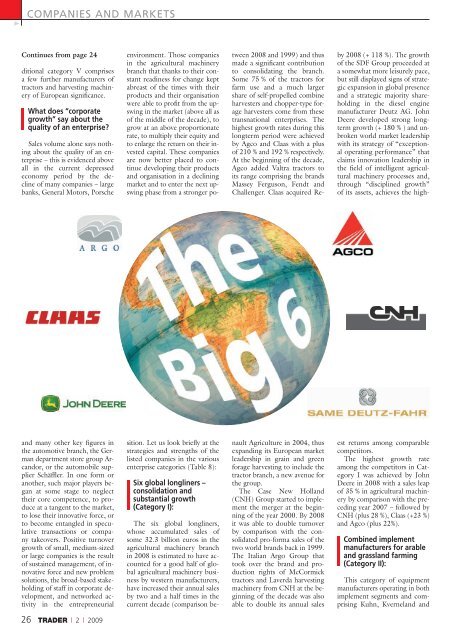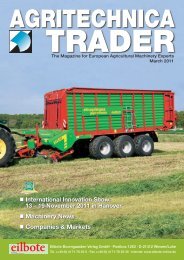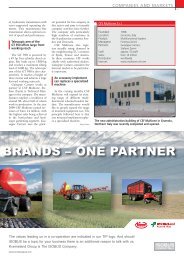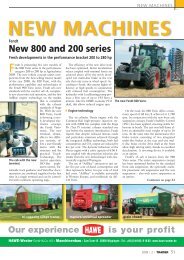Titel-Trader 2.2009.indd - Agritechnica Trader
Titel-Trader 2.2009.indd - Agritechnica Trader
Titel-Trader 2.2009.indd - Agritechnica Trader
Create successful ePaper yourself
Turn your PDF publications into a flip-book with our unique Google optimized e-Paper software.
COMPANIES AND MARKETS<br />
Continues from page 24<br />
ditional category V comprises<br />
a few further manufacturers of<br />
tractors and harvesting machinery<br />
of European signifi cance.<br />
What does “corporate<br />
growth” say about the<br />
quality of an enterprise?<br />
Sales volume alone says nothing<br />
about the quality of an enterprise<br />
– this is evidenced above<br />
all in the current depressed<br />
economy period by the decline<br />
of many companies – large<br />
banks, General Motors, Porsche<br />
and many other key fi gures in<br />
the automotive branch, the German<br />
department store group Arcandor,<br />
or the automobile supplier<br />
Schäffl er. In one form or<br />
another, such major players began<br />
at some stage to neglect<br />
their core competence, to produce<br />
at a tangent to the market,<br />
to lose their innovative force, or<br />
to become entangled in speculative<br />
transactions or company<br />
takeovers. Positive turnover<br />
growth of small, medium-sized<br />
or large companies is the result<br />
of sustained management, of innovative<br />
force and new problem<br />
solutions, the broad-based stakeholding<br />
of staff in corporate development,<br />
and networked activity<br />
in the entrepreneurial<br />
26 TRADER | 2 | 2009<br />
environment. Those companies<br />
in the agricultural machinery<br />
branch that thanks to their constant<br />
readiness for change kept<br />
abreast of the times with their<br />
products and their organisation<br />
were able to profi t from the upswing<br />
in the market (above all as<br />
of the middle of the decade), to<br />
grow at an above proportionate<br />
rate, to multiply their equity and<br />
to enlarge the return on their invested<br />
capital. These companies<br />
are now better placed to continue<br />
developing their products<br />
and organisation in a declining<br />
market and to enter the next upswing<br />
phase from a stronger po-<br />
sition. Let us look briefl y at the<br />
strategies and strengths of the<br />
listed companies in the various<br />
enterprise categories (Table 8):<br />
Six global longliners –<br />
consolidation and<br />
substantial growth<br />
(Category I):<br />
The six global longliners,<br />
whose accumulated sales of<br />
some 32.3 billion euros in the<br />
agricultural machinery branch<br />
in 2008 is estimated to have accounted<br />
for a good half of global<br />
agricultural machinery business<br />
by western manufacturers,<br />
have increased their annual sales<br />
by two and a half times in the<br />
current decade (comparison be-<br />
tween 2008 and 1999) and thus<br />
made a signifi cant contribution<br />
to consolidating the branch.<br />
Some 75 % of the tractors for<br />
farm use and a much larger<br />
share of self-propelled combine<br />
harvesters and chopper-type forage<br />
harvesters come from these<br />
transnational enterprises. The<br />
highest growth rates during this<br />
longterm period were achieved<br />
by Agco and Claas with a plus<br />
of 210 % and 192 % respectively.<br />
At the beginning of the decade,<br />
Agco added Valtra tractors to<br />
its range comprising the brands<br />
Massey Ferguson, Fendt and<br />
Challenger. Claas acquired Re-<br />
nault Agriculture in 2004, thus<br />
expanding its European market<br />
leadership in grain and green<br />
forage harvesting to include the<br />
tractor branch, a new avenue for<br />
the group.<br />
The Case New Holland<br />
(CNH) Group started to implement<br />
the merger at the beginning<br />
of the year 2000. By 2008<br />
it was able to double turnover<br />
by comparison with the consolidated<br />
pro-forma sales of the<br />
two world brands back in 1999.<br />
The Italian Argo Group that<br />
took over the brand and production<br />
rights of McCormick<br />
tractors and Laverda harvesting<br />
machinery from CNH at the beginning<br />
of the decade was also<br />
able to double its annual sales<br />
by 2008 (+ 118 %). The growth<br />
of the SDF Group proceeded at<br />
a somewhat more leisurely pace,<br />
but still displayed signs of strategic<br />
expansion in global presence<br />
and a strategic majority shareholding<br />
in the diesel engine<br />
manufacturer Deutz AG. John<br />
Deere developed strong longterm<br />
growth (+ 180 % ) and unbroken<br />
world market leadership<br />
with its strategy of “exceptional<br />
operating performance” that<br />
claims innovation leadership in<br />
the fi eld of intelligent agricultural<br />
machinery processes and,<br />
through “disciplined growth”<br />
of its assets, achieves the high-<br />
est returns among comparable<br />
competitors.<br />
The highest growth rate<br />
among the competitors in Category<br />
I was achieved by John<br />
Deere in 2008 with a sales leap<br />
of 35 % in agricultural machinery<br />
by comparison with the preceding<br />
year 2007 – followed by<br />
CNH (plus 28 %), Claas (+23 %)<br />
and Agco (plus 22%).<br />
Combined implement<br />
manufacturers for arable<br />
and grassland farming<br />
(Category II):<br />
This category of equipment<br />
manufacturers operating in both<br />
implement segments and comprising<br />
Kuhn, Kverneland and






